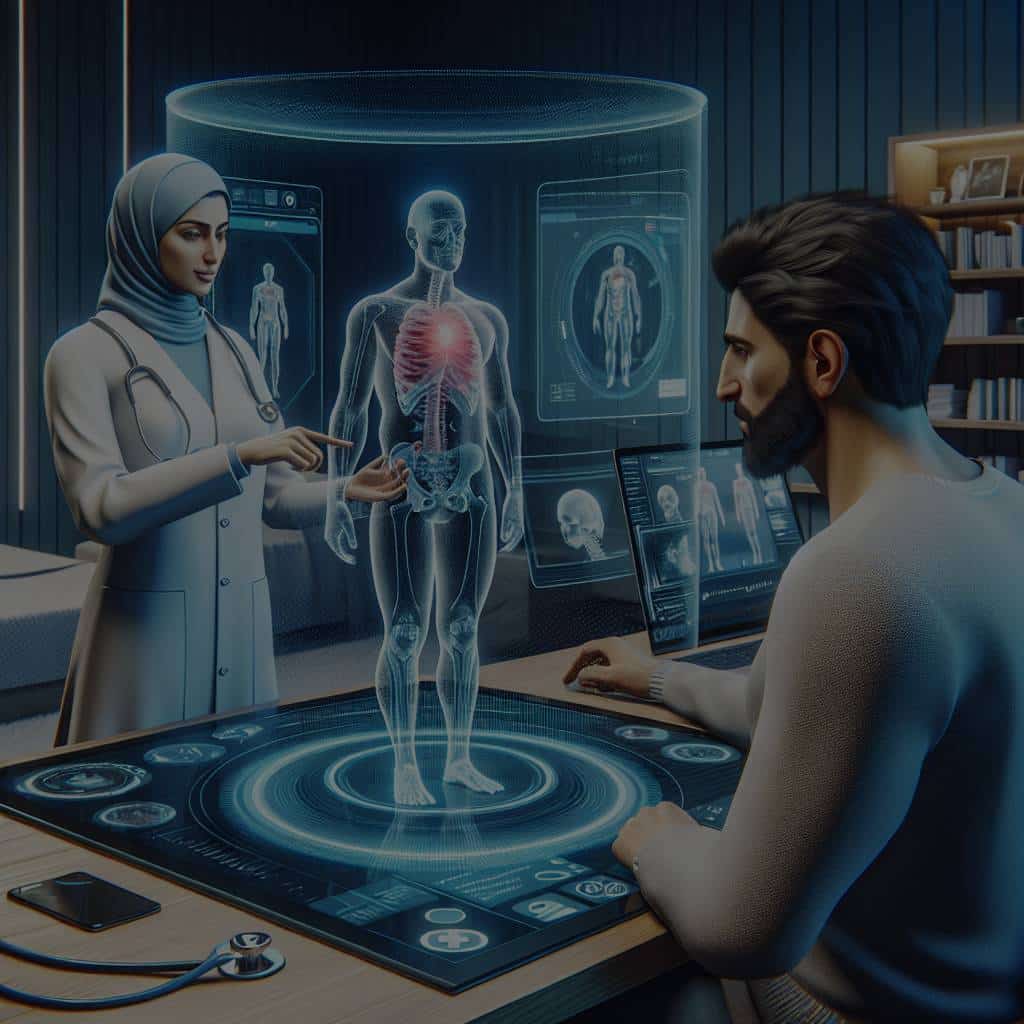What Role Does 3D Holography Play in Enhancing Telemedicine Consultations?

The medical world is experiencing a rapid transformation brought about by the consistent integration of technology in healthcare. The digital realm has become an integral part of the healthcare industry, bringing about revolutions in patient care, treatment procedures, data management, and most importantly, medical education. One such groundbreaking innovation is 3D Holography, a fusion of augmented reality and digital imaging. This advanced technology has been playing a critical role in enhancing telemedicine consultations, revolutionizing remote healthcare, and expanding the horizons of medical learning and patient education.
3D Holography: A Boon for Remote Patient Care
The concept of telemedicine has brought about a significant shift in the traditional healthcare system. It made healthcare more accessible and convenient for patients, especially those residing in remote areas, by eliminating geographical barriers.
Lire également : How Could Virtual Power Plants Revolutionize Residential Energy Management?
3D Holography has turned out to be a game-changer in this realm. It is a dynamic technology that uses a crossref of virtual reality and digital imaging to create a real-life, three-dimensional image of an object or a person. It has significantly enhanced the quality and effectiveness of remote patient care by providing a more accurate and in-depth analysis of the patient’s health condition.
Through 3D Holography, healthcare professionals can visualize the patient’s body parts in a three-dimensional format, enabling them to diagnose health conditions with higher precision. This technology also allows doctors to explain the treatment procedures to their patients in a more understandable and comprehensive manner. They can demonstrate the surgical procedures or medication effects using the 3D holographic models, thereby enhancing patient education about their health conditions and treatments.
Avez-vous vu cela : Can Synthetic Data Overcome Privacy Concerns in AI Facial Recognition Training?
Augmenting Medical Education through 3D Holography
Medical education is another crucial aspect that has been significantly enhanced with the advent of 3D holography. The traditional methods of learning through books and two-dimensional images often fail to provide a comprehensive understanding of the human anatomy and its functioning.
By leveraging the capabilities of 3D holography, medical students can now visualize and understand complex medical conditions, surgical procedures, and the intricate structure of various body organs in a much realistic manner. This technology provides a virtual yet real-like experience, which is crucial in medical learning.
3D holography also paves the way for interactive learning. Students can manipulate the 3D holographic images, enabling them to get a 360-degree view and a deeper understanding of the subject. This innovative learning approach enhances their practical skills, preparing them better for the real healthcare environment.
Enhancing Therapy and Rehabilitation with 3D Holography
Therapy and rehabilitation are other essential areas of healthcare that can greatly benefit from 3D holography. This technology has the potential to revolutionize various forms of therapy, including physical therapy, cognitive therapy, and even mental health therapy.
For instance, in physical therapy, 3D holography can be used to create a three-dimensional image of the patient’s affected area. This enables the therapists to understand the extent of damage or injury and develop a more accurate and effective treatment plan.
In terms of cognitive therapy, 3D holography can be used to create immersive, real-like scenarios that help in treating conditions like dementia, Alzheimer’s disease, and other cognitive disorders. Patients can interact with these scenarios, which aids in enhancing their cognitive abilities.
The Future of Medical Imaging with 3D Holography
Medical imaging has always been a critical component of healthcare. It provides the foundation for diagnosing various health conditions, planning the treatment procedures, and tracking the progress of the treatment. With the advent of 3D Holography, medical imaging has been taken to a whole new level.
3D holography enables healthcare professionals to analyze the imaging data in a three-dimensional format, providing a more detailed and comprehensive view. It allows them to visualize the internal structures of the body in a real-like manner, thereby enhancing their ability to diagnose and treat health conditions.
Moreover, 3D holography also plays a critical role in surgical planning. Surgeons can use 3D holographic images to plan and practice the surgical procedures beforehand, thereby reducing the risks associated with the surgery. This not only improves the effectiveness of the treatment but also enhances the safety and comfort of the patients.
The fusion of healthcare and technology has indeed revolutionized the medical world. 3D Holography is one such innovative technology that is shaping the future of healthcare, enhancing the effectiveness of telemedicine consultations, and taking patient care, medical education, therapy, and medical imaging to new heights.
Incorporating 3D Holography in Mental Health Care
Following the advent of technology, mental health care has seen tremendous transformations. The use of 3D Holography in mental healthcare represents yet another significant leap in this sector. The capability of 3D holography to create real-time, lifelike scenarios can be used to enhance the quality of therapy sessions, making them more interactive and engaging.
This technology can be leveraged to create virtual reality environments that provide a more realistic and immersive therapeutic experience. For instance, 3D holography can be used to simulate real-life situations that cause anxiety or stress in patients. This allows healthcare professionals to observe the patients’ reactions and develop effective strategies to manage these conditions.
Additionally, 3D holography can also play a crucial role in treating conditions like Post Traumatic Stress Disorder (PTSD). By recreating the traumatic events in a controlled environment, therapists can help the patients confront their fears and eventually overcome them. Moreover, 3D holography has been used to create guided meditation or relaxation sessions, which have been found to be effective in managing mental health conditions like depression and anxiety.
By enhancing the quality of therapy sessions, 3D holography can significantly improve the outcomes of mental health treatments and contribute to the overall well-being of the patients.
3D Holography: Revolutionizing Medical Training
The integration of 3D holography in medical training represents a significant revolution in the healthcare industry. This technology provides a platform for interactive learning, where medical students can manipulate the holographic images, giving them a comprehensive understanding of the human anatomy.
3D Holography provides a 360-degree view of the body organs, allowing the students to explore them from various angles. This is particularly beneficial in understanding the complex structures and functions of the organs. Moreover, the use of real-time, three-dimensional images enhances the practical skills of the students, preparing them better for real-life medical scenarios.
The technology also paves the way for virtual reality surgeries. Medical students can use 3D holographic images to practice surgical procedures in a risk-free environment. This not only improves their surgical skills but also enhances their confidence, which is crucial in the field of medicine.
The use of 3D holography in medical training also extends to the ongoing COVID pandemic situation. With the restrictions on physical classes, 3D holography can provide an effective alternative for hands-on training, allowing the students to continue their learning without any disruptions.
Conclusion
The role of 3D holography in enhancing telemedicine consultations is indeed significant. By providing a platform for real-time, three-dimensional visualization, 3D holography has revolutionized remote patient care, medical education, and therapy. The use of this technology in mental health care and medical training represents a significant leap in the healthcare industry.
As we continue to navigate through the digital age, the role of 3D holography in healthcare is expected to grow even more. The possibilities are endless – from improving the quality of patient care to enhancing the effectiveness of medical training, 3D holography holds the potential to reshape the future of healthcare. It is evident that the fusion of healthcare and technology is not just about improving the effectiveness of treatments but also about enhancing the overall quality of life.
Despite the many benefits, the adoption of 3D holography in healthcare still comes with its challenges, including the need for technical expertise and high costs associated with the technology. However, with continued research and development, it is hoped that these challenges can be overcome, and 3D holography can become a mainstream technology in the healthcare industry.
